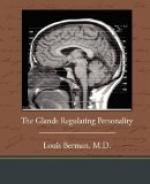The history of a thymocentric type, for instance, is predictable from the very first few months of his life. Difficulties in feeding, in habit formation and adaptation, in the reaction to infections, in social play and so on, one may expect for him. The course of events for the other endocrine types also follow laws of their own. It will be above all in the understanding of children, their make-up, reactions and powers, that the biologist will achieve some of his finest triumphs.
The educator will have to take account of the state of the pituitary in estimating the normal intelligence, or influencing the abnormal or subnormal intelligence. As well will he have to consider the thyroid in the child whose conduct is refractory, even though his proficiency in his studies is excellent. And the condition of the adrenal will be ascertained in the types that tire easily, and that seem unable to make the effort necessary or desirable. Periodic seasonal and critical fluctuations in the equilibrium among the hormones will have to be taken into account in the explanation of what have hitherto been put down to laziness, naughtiness, stupidity, or obstinacy.
A child’s capacity for education, essentially its capacity for the highest and most productive kind of life, is limited by inherent factors. These factors are two: the quality of the nerve tissue, its ability to make a number of associations, and the quantity of the internal secretions, measured by the maximum obtainable in a given situation. These inherent factors explain, too, why children born and bred in virtually the same environment show the most extreme differences in educability. That the differences are inherited was made evident by Galton’s finding that the chance of the son of an eminent man exhibiting eminent ability was 500 times as great as that of the son of a man taken at random.
Every baby, then, is born with a combination of nerve cells and ductless glands which determine its capacity for mental development, that might never be realized, but could never be exceeded. If, in any family, minor differences in educability are observed, they can be put down to disturbance of these two factors occurring after the fertilized germ cell had started to divide and reproduce itself. But any marked falling off in either the nervous or endocrine factors has to be considered pathologic, due to an impairment of them by adverse environment.
Recent studies have amply established that the proportion of certifiable mental defectives, and of a much larger class, the subnormal but not certifiable class, is progressing by leaps and bounds. It is perhaps the most absurd frailty of our present system of education that it takes almost no account of innate differences in educability. To spend money upon the teaching of these children along lines where they are unteachable is not only waste pure and simple, but crime, for it deprives the educables of their just due.




